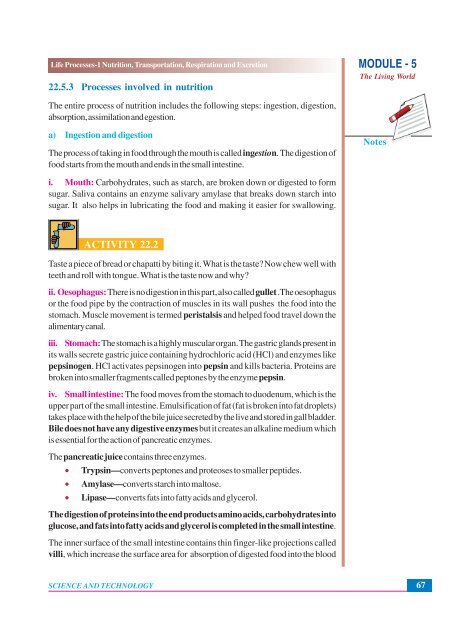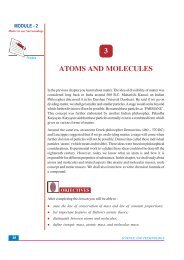Nutrition, Transportation, Respiration and Excretion
Nutrition, Transportation, Respiration and Excretion
Nutrition, Transportation, Respiration and Excretion
You also want an ePaper? Increase the reach of your titles
YUMPU automatically turns print PDFs into web optimized ePapers that Google loves.
Life Processes-1 <strong>Nutrition</strong>, <strong>Transportation</strong>, <strong>Respiration</strong> <strong>and</strong> <strong>Excretion</strong><br />
22.5.3 Processes involved in nutrition<br />
MODULE - 5<br />
The Living World<br />
The entire process of nutrition includes the following steps: ingestion, digestion,<br />
absorption, assimilation <strong>and</strong> egestion.<br />
a) Ingestion <strong>and</strong> digestion<br />
The process of taking in food through the mouth is called ingestion. The digestion of<br />
food starts from the mouth <strong>and</strong> ends in the small intestine.<br />
Notes<br />
i. Mouth: Carbohydrates, such as starch, are broken down or digested to form<br />
sugar. Saliva contains an enzyme salivary amylase that breaks down starch into<br />
sugar. It also helps in lubricating the food <strong>and</strong> making it easier for swallowing.<br />
ACTIVITY 22.2<br />
Taste a piece of bread or chapatti by biting it. What is the taste? Now chew well with<br />
teeth <strong>and</strong> roll with tongue. What is the taste now <strong>and</strong> why?<br />
ii. Oesophagus: There is no digestion in this part, also called gullet .The oesophagus<br />
or the food pipe by the contraction of muscles in its wall pushes the food into the<br />
stomach. Muscle movement is termed peristalsis <strong>and</strong> helped food travel down the<br />
alimentary canal.<br />
iii. Stomach: The stomach is a highly muscular organ. The gastric gl<strong>and</strong>s present in<br />
its walls secrete gastric juice containing hydrochloric acid (HCl) <strong>and</strong> enzymes like<br />
pepsinogen. HCl activates pepsinogen into pepsin <strong>and</strong> kills bacteria. Proteins are<br />
broken into smaller fragments called peptones by the enzyme pepsin.<br />
iv. Small intestine: The food moves from the stomach to duodenum, which is the<br />
upper part of the small intestine. Emulsification of fat (fat is broken into fat droplets)<br />
takes place with the help of the bile juice secreted by the live <strong>and</strong> stored in gall bladder.<br />
Bile does not have any digestive enzymes but it creates an alkaline medium which<br />
is essential for the action of pancreatic enzymes.<br />
The pancreatic juice contains three enzymes.<br />
• Trypsin—converts peptones <strong>and</strong> proteoses to smaller peptides.<br />
• Amylase—converts starch into maltose.<br />
• Lipase—converts fats into fatty acids <strong>and</strong> glycerol.<br />
The digestion of proteins into the end products amino acids, carbohydrates into<br />
glucose, <strong>and</strong> fats into fatty acids <strong>and</strong> glycerol is completed in the small intestine.<br />
The inner surface of the small intestine contains thin finger-like projections called<br />
villi, which increase the surface area for absorption of digested food into the blood<br />
SCIENCE AND TECHNOLOGY<br />
67
















